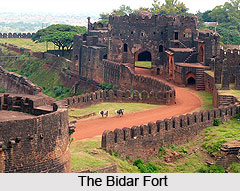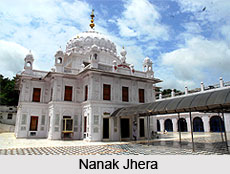 In the northern-most part of Karnataka lies Bidar - a tiny district steeped in history. As you enter the town, the Bidar Fort welcomes you with five darwazas (gates) that lead into a little town nestling within the ramparts. Enter from the Gumbaz Darwaza and steps lead you to the Rangin Mahal.
In the northern-most part of Karnataka lies Bidar - a tiny district steeped in history. As you enter the town, the Bidar Fort welcomes you with five darwazas (gates) that lead into a little town nestling within the ramparts. Enter from the Gumbaz Darwaza and steps lead you to the Rangin Mahal.
The royal residence has elaborately carved wooden pillars, Persian couplets engraved in encaustic tiles and exquisite mother - of - pearl in lay work. The Solah Khamba Masjid is the oldest Muslim building in Bidar and one of the largest in India. Not to be missed are the Gagan Mahal, the Diwan-E-Am where the fabulous turquoise throne once rested, the Takht Mahal, the Royal Pavilions, the Hazar Kothari, the Nubat Khana and the Bahamani Tombs at Asthur.
Inner Fort
Till in good condition, the present structure appears to be the work of Muhammad Shah Bahamani and Ali Barid. The latter was responsible for mounting the many canons and guns on the battlements. The fort has five gates with imposing bastions and each has peculiar attraction of its own.
Shara Darwaza
The old drawbridge was the first gateway and that having filled up, the Shara Darwaza gateway was constructed. The outside walls have encaustic tile work. The upper rooms in this gateway served as a `Naqqar Khana`, the room housing drums and trumpets. The figures of tigers on either side of the entrance are common in Deccan forts and probably signify the Shia belief that these represented Ali and hence the fort would be free from attack.
Gumbaz Darwaza
The next doorway is typical of the contemporary Tughlaq Architecture seen in Delhi, though traces of Persian influence can also be seen. This was probably built by 1420 AD, by Ahmad Shah Wali. The triple moat can be seen to the right of the road leading into the somber doorway.
The Royal Bath & Kitchen
 The `shahi matbaks` are the buildings close to the big banyan tree and in an earlier period must have been the palace of a noble. These were also the royal kitchens. `Shahi Hamaam` as it was called, is now the local museum wherein some remarkable images of the Hindu period, rare old china used in the royal households, besides hollow cannon-balls filled with iron pieces can be seen. Right in the heart of Bidar town stands the Chaubara a 71-foot tower. You can have a splendid view from the top of the Chaubara.
The `shahi matbaks` are the buildings close to the big banyan tree and in an earlier period must have been the palace of a noble. These were also the royal kitchens. `Shahi Hamaam` as it was called, is now the local museum wherein some remarkable images of the Hindu period, rare old china used in the royal households, besides hollow cannon-balls filled with iron pieces can be seen. Right in the heart of Bidar town stands the Chaubara a 71-foot tower. You can have a splendid view from the top of the Chaubara.
Nanak Jhera
The famous Nanak Jhera - the largest Sikh temple atleast in Karnataka, carries the tale that Guru Nanak - the first guru of the Sikhs visited this place and got rid of the scarcity of drinking water in the region. A popular spot is the Sikh temple, Guru Nanak Jhera, where fresh crystal clear spring water appears from nowhere.
Rangin Mahal
The colourful palace near the Gumbaz Darwaza is famous for its woodwork and the mother-of-pearl inlay work. The outer hall was for the purpose of giving audience and the wooden pillars are elaborately carved.
Solah Khamba Masjid
The sixteen columned prayer hall was built in 1423 AD by Prince Muhammad even prior to the shifting of the capital to Bidar by the Bahamanis. This is the oldest Muslim building in Bidar and among the largest in India.
 Takht Mahal
Takht Mahal
The ruins of the royal palace point to the architectural exuberance. The lowlands and the western fortifications afford a splendid view of the palace.
Gagan Mahal
This is an earlier palace of the Dakamanis and is reaches from behind the masjid. The entrance to the outer court has a four-centred arch reminding one of the Tudor architecture.
Tarakash Mahal
These are pile of ruins adjoining the masjid and originally consisted of the apartments of the female members of the royal household. The ladies occupied the upper apartments while the lower portions housed the guards and the storerooms.
Madarasa of Mahamud Gawan
It is another important building in Bidar. This university was once a renowned centre of learning, attracting scholars from all over the Muslim world. The rock temple at Narasimha Zarni is also worth a visit. Situated in a big cave, the temple is carved into the plateau and to approach the deity, you`ll have to wad through water.

Basavakalyan
The ancient town of Basavakalyana - 80 Kms away, embracing a large area "surpassed in beauty and splendour all other cities in the world." It became a seat of learning and an abode of spiritual wisdom. Even today Basavakalyan is remembered for the saints who made this city their home - Basaveshwara, Akka - mahadevi, Channabasavanna and Siddharama.
How to get there ?
Air - The nearest airport is Hyderabad.
Rail - Bidar is connected by rail with Bangalore, Bombay and Hyderabad.
Road - Bidar is connected by road to: Hyderabad (136 kms) Bangalore (669 kms) Bijapur (246 kms) Gulbarga (110 kms) Basavakalyana (73 kms) KSRTC Buses ply from Bidar to Bangalore, Bijapur, Gulbarga, Raichur and Sholapur.



















